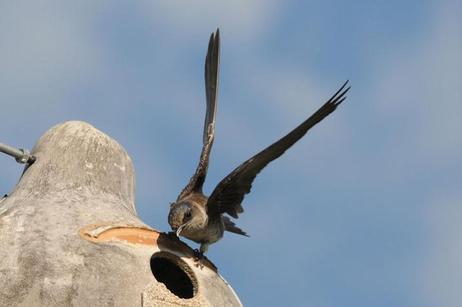Purple Martin Migration Secrets - published April 18, 2013

Purple martins, the largest members of the swallow family, are among our most beautiful and fascinating avian neighbours.
Interestingly, martins and humans have been connected for at least 7,000 years; scientists believe that purple martins first started nesting in the long-necked gourds used as drinking utensils by Southern-dwelling American Indians. Fascinated, the villagers put up additional gourds to encourage the birds to nest close by. European settlers, equally enthralled, carried on the gourd tradition and also began building multi-compartment wooden houses. The use of gourds and apartment-styles houses became so widespread that, by the early 20th century, martins had forsaken woodpecker cavities and other ancestral nesting cavities. Today, thousands of purple martin “landlords” host colonies of these birds all across the continent. Interestingly, the Eastern subspecies (Progne subis subis) has the singular distinction of being totally dependent on human-supplied nesting sites. Ironically, purple martin popularity increased dramatically in the early 1960s because a few overzealous martin house manufacturers claimed that each bird would consume over 2,000 (even up to 14,000) mosquitoes daily! However, subsequent scientific studies confirmed that martins do not eat mosquitoes; rather, they consume dragonflies, damselflies and other larger insects. Mosquitoes — which fly low, hang out in the shade and are not active when the martins are feeding — are hardly worth the chase. The relentless marketing campaign was obviously successful because the mosquito myth is still widely believed. |
Purple martins are birds of Alberta’s Parklands, and those nesting here are at the northern limit of their breeding range. Our Ellis Bird Farm colony is one of dozens around Central Alberta. Although the martin population is decreasing overall, farm numbers continue to grow. We hosted a record 70 nesting pairs last year and their melodious chatter has become the signature sound at our site.
Last summer, the farm embarked on a purple martin research project in conjunction with Toronto’s York University, the Purple Martin Conservancy of Pigeon Lake and the Camrose Wildlife and Stewardship Society. Twenty two farm birds were “outfitted” with small light level geolocator backpacks. These geolocators detect and record maximum light intensities at set intervals, data from which researchers can reconstruct migration routes and identify wintering locations. No one knows where “our” Northern-nesting martins overwinter, so these geo’d martins carry critically important scientific information on their backs! The challenge this season is to find all the “backpacked” birds that return to Alberta. This spring, we are asking martin landlords in Central Alberta to carefully check all the martins that show up at their colonies. The antennae of these units are difficult to see, but the aluminum leg bands put on all geo’d birds will be fairly easy to spot (some geo’d birds also have green or black coloured leg bands). If a banded/backpacked martin is observed, we invite you to call Ellis Bird Farm immediately (403-346-2211) or drop us an email ([email protected]). We will visit your colony to gently trap the geo’d bird and remove the backpack. Oh, the secrets that will be revealed! |



